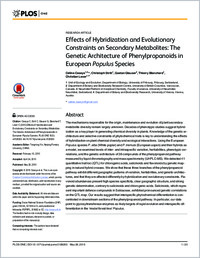Effects of hybridization and evolutionary constraints on secondary metabolites: the genetic architecture of phenylpropanoids in european Populus species
- Caseys, Celine Unit of Ecology and Evolution, Department of Biology, University of Fribourg, Switzerland - Department of Botany and Biodiversity Research Centre, University of British Columbia, Vancouver, Canada
- Stritt, Christoph Unit of Ecology and Evolution, Department of Biology, University of Fribourg, Switzerland
- Glauser, Gaetan Neuchâtel Platform of Analytical Chemistry, Faculty of science, University of Neuchâtel, Switzerland
- Blanchard, Thierry Unit of Ecology and Evolution, Department of Biology, University of Fribourg, Switzerland
- Lexer, Christian Unit of Ecology and Evolution, Department of Biology, University of Fribourg, Switzerland - Department of Botany and Biodiversity Research, University of Vienna, Austria
-
26.05.2015
Published in:
- PLoS ONE. - 2015, vol. 10, no. 5, p. e0128200
English
The mechanisms responsible for the origin, maintenance and evolution of plant secondary metabolite diversity remain largely unknown. Decades of phenotypic studies suggest hybridization as a key player in generating chemical diversity in plants. Knowledge of the genetic architecture and selective constraints of phytochemical traits is key to understanding the effects of hybridization on plant chemical diversity and ecological interactions. Using the European Populus species P. alba (White poplar) and P. tremula (European aspen) and their hybrids as a model, we examined levels of inter- and intraspecific variation, heritabilities, phenotypic correlations, and the genetic architecture of 38 compounds of the phenylpropanoid pathway measured by liquid chromatography and mass spectrometry (UHPLC-MS). We detected 41 quantitative trait loci (QTL) for chlorogenic acids, salicinoids and flavonoids by genetic mapping in natural hybrid crosses. We show that these three branches of the phenylpropanoid pathway exhibit different geographic patterns of variation, heritabilities, and genetic architectures, and that they are affected differently by hybridization and evolutionary constraints. Flavonoid abundances present high species specificity, clear geographic structure, and strong genetic determination, contrary to salicinoids and chlorogenic acids. Salicinoids, which represent important defence compounds in Salicaceae, exhibited pronounced genetic correlations on the QTL map. Our results suggest that interspecific phytochemical differentiation is concentrated in downstream sections of the phenylpropanoid pathway. In particular, our data point to glycosyltransferase enzymes as likely targets of rapid evolution and interspecific differentiation in the ‘model forest tree’ Populus.
- Faculty
- Faculté des sciences et de médecine
- Department
- Département de Biologie
- Language
-
- English
- Classification
- Biological sciences
- License
- License undefined
- Identifiers
-
- RERO DOC 257071
- DOI 10.1371/journal.pone.0128200
- Persistent URL
- https://folia.unifr.ch/unifr/documents/304602
Other files
Statistics
Document views: 72
File downloads:
- lex_ehe.pdf: 156
- lex_ehe_sm.pdf: 83

